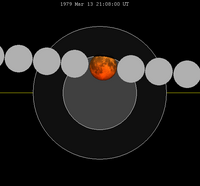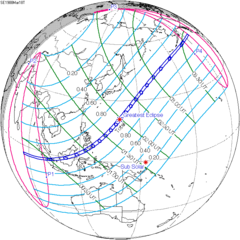| Partial eclipse | |||||||||||||
 The Moon's hourly motion shown right to left The Moon's hourly motion shown right to left | |||||||||||||
| Date | March 13, 1979 | ||||||||||||
|---|---|---|---|---|---|---|---|---|---|---|---|---|---|
| Gamma | 0.5254 | ||||||||||||
| Magnitude | 0.8538 | ||||||||||||
| Saros cycle | 132 (28 of 71) | ||||||||||||
| Partiality | 197 minutes, 39 seconds | ||||||||||||
| Penumbral | 350 minutes, 37 seconds | ||||||||||||
| |||||||||||||
| ← September 1978September 1979 → | |||||||||||||
A partial lunar eclipse occurred at the Moon’s ascending node of orbit on Tuesday, March 13, 1979, with an umbral magnitude of 0.8538. A lunar eclipse occurs when the Moon moves into the Earth's shadow, causing the Moon to be darkened. A partial lunar eclipse occurs when one part of the Moon is in the Earth's umbra, while the other part is in the Earth's penumbra. Unlike a solar eclipse, which can only be viewed from a relatively small area of the world, a lunar eclipse may be viewed from anywhere on the night side of Earth. Occurring about 3.5 days after apogee (on March 10, 1979, at 10:20 UTC), the Moon's apparent diameter was smaller.
Visibility
The eclipse was completely visible over much of Africa, Europe, and the western half of Asia, seen rising over eastern North America, South America, and west Africa and setting over east and northeast Asia and Australia.
 
|
Eclipse details
Shown below is a table displaying details about this particular solar eclipse. It describes various parameters pertaining to this eclipse.
| Parameter | Value |
|---|---|
| Penumbral Magnitude | 1.93496 |
| Umbral Magnitude | 0.85377 |
| Gamma | 0.52537 |
| Sun Right Ascension | 23h33m09.8s |
| Sun Declination | -02°53'59.0" |
| Sun Semi-Diameter | 16'05.4" |
| Sun Equatorial Horizontal Parallax | 08.8" |
| Moon Right Ascension | 11h33m44.4s |
| Moon Declination | +03°21'20.5" |
| Moon Semi-Diameter | 14'52.9" |
| Moon Equatorial Horizontal Parallax | 0°54'36.9" |
| ΔT | 49.7 s |
Eclipse season
See also: Eclipse cycleThis eclipse is part of an eclipse season, a period, roughly every six months, when eclipses occur. Only two (or occasionally three) eclipse seasons occur each year, and each season lasts about 35 days and repeats just short of six months (173 days) later; thus two full eclipse seasons always occur each year. Either two or three eclipses happen each eclipse season. In the sequence below, each eclipse is separated by a fortnight.
| February 26 Descending node (new moon) |
March 13 Ascending node (full moon) |
|---|---|
 |

|
| Total solar eclipse Solar Saros 120 |
Partial lunar eclipse Lunar Saros 132 |
Related eclipses
Eclipses in 1979
- A total solar eclipse on February 26.
- A partial lunar eclipse on March 13.
- An annular solar eclipse on August 22.
- A total lunar eclipse on September 6.
Metonic
- Preceded by: Lunar eclipse of May 25, 1975
- Followed by: Lunar eclipse of December 30, 1982
Tzolkinex
- Preceded by: Lunar eclipse of January 30, 1972
- Followed by: Lunar eclipse of April 24, 1986
Half-Saros
- Preceded by: Solar eclipse of March 7, 1970
- Followed by: Solar eclipse of March 18, 1988
Tritos
- Preceded by: Lunar eclipse of April 13, 1968
- Followed by: Lunar eclipse of February 9, 1990
Lunar Saros 132
- Preceded by: Lunar eclipse of March 2, 1961
- Followed by: Lunar eclipse of March 24, 1997
Inex
- Preceded by: Lunar eclipse of April 2, 1950
- Followed by: Lunar eclipse of February 21, 2008
Triad
- Preceded by: Lunar eclipse of May 11, 1892
- Followed by: Lunar eclipse of January 11, 2066
Lunar eclipses of 1977–1980
This eclipse is a member of a semester series. An eclipse in a semester series of lunar eclipses repeats approximately every 177 days and 4 hours (a semester) at alternating nodes of the Moon's orbit.
The penumbral lunar eclipse on July 27, 1980 occurs in the next lunar year eclipse set.
| Lunar eclipse series sets from 1977 to 1980 | ||||||||
|---|---|---|---|---|---|---|---|---|
| Ascending node | Descending node | |||||||
| Saros | Date Viewing |
Type Chart |
Gamma | Saros | Date Viewing |
Type Chart |
Gamma | |
| 112 | 1977 Apr 04
|
Partial
|
−0.9148 | 117 | 1977 Sep 27
|
Penumbral
|
1.0768 | |
| 122 | 1978 Mar 24
|
Total
|
−0.2140 | 127 | 1978 Sep 16
|
Total
|
0.2951 | |
| 132 | 1979 Mar 13
|
Partial
|
0.5254 | 137 | 1979 Sep 06
|
Total
|
−0.4305 | |
| 142 | 1980 Mar 01
|
Penumbral
|
1.2270 | 147 | 1980 Aug 26
|
Penumbral
|
−1.1608 | |
Saros 132
This eclipse is a part of Saros series 132, repeating every 18 years, 11 days, and containing 71 events. The series started with a penumbral lunar eclipse on May 12, 1492. It contains partial eclipses from August 16, 1636 through March 24, 1997; total eclipses from April 4, 2015 through August 2, 2213; and a second set of partial eclipses from August 13, 2231 through November 30, 2411. The series ends at member 71 as a penumbral eclipse on June 26, 2754.
The longest duration of totality will be produced by member 36 at 106 minutes, 6 seconds on June 9, 2123. All eclipses in this series occur at the Moon’s ascending node of orbit.
| Greatest | First | |||
|---|---|---|---|---|
 The greatest eclipse of the series will occur on 2123 Jun 09, lasting 106 minutes, 6 seconds. |
Penumbral | Partial | Total | Central |
1492 May 12
|
1636 Aug 16
|
2015 Apr 04
|
2069 May 06
| |
| Last | ||||
| Central | Total | Partial | Penumbral | |
2177 Jul 11
|
2213 Aug 02
|
2411 Nov 30 |
2754 Jun 26
| |
Eclipses are tabulated in three columns; every third eclipse in the same column is one exeligmos apart, so they all cast shadows over approximately the same parts of the Earth.
| Series members 19–40 occur between 1801 and 2200: | |||||
|---|---|---|---|---|---|
| 19 | 20 | 21 | |||
| 1816 Dec 04 | 1834 Dec 16 | 1852 Dec 26 | |||
| 22 | 23 | 24 | |||
| 1871 Jan 06 | 1889 Jan 17 | 1907 Jan 29 | |||

|

| ||||
| 25 | 26 | 27 | |||
| 1925 Feb 08 | 1943 Feb 20 | 1961 Mar 02 | |||

|

|

|

|

|

|
| 28 | 29 | 30 | |||
| 1979 Mar 13 | 1997 Mar 24 | 2015 Apr 04 | |||

|

|

|

|

|

|
| 31 | 32 | 33 | |||
| 2033 Apr 14 | 2051 Apr 26 | 2069 May 06 | |||

|

|

|

|

|

|
| 34 | 35 | 36 | |||
| 2087 May 17 | 2105 May 28 | 2123 Jun 09 | |||

|

|

|
|||
| 37 | 38 | 39 | |||
| 2141 Jun 19 | 2159 Jun 30 | 2177 Jul 11 | |||
| 40 | |||||
| 2195 Jul 22 | |||||
Half-Saros cycle
A lunar eclipse will be preceded and followed by solar eclipses by 9 years and 5.5 days (a half saros). This lunar eclipse is related to two total solar eclipses of Solar Saros 139.
| March 7, 1970 | March 18, 1988 |
|---|---|

|

|
See also
Notes
- "March 13–14, 1979 Partial Lunar Eclipse". timeanddate. Retrieved 4 January 2025.
- "Moon Distances for London, United Kingdom, England". timeanddate. Retrieved 4 January 2025.
- "Partial Lunar Eclipse of 1979 Mar 13" (PDF). NASA. Retrieved 4 January 2025.
- "Partial Lunar Eclipse of 1979 Mar 13". EclipseWise.com. Retrieved 4 January 2025.
- van Gent, R.H. "Solar- and Lunar-Eclipse Predictions from Antiquity to the Present". A Catalogue of Eclipse Cycles. Utrecht University. Retrieved 6 October 2018.
- "NASA - Catalog of Lunar Eclipses of Saros 132". eclipse.gsfc.nasa.gov.
- Listing of Eclipses of series 132
- Mathematical Astronomy Morsels, Jean Meeus, p.110, Chapter 18, The half-saros
External links
- 1979 Mar 13 chart Eclipse Predictions by Fred Espenak, NASA/GSFC
This lunar eclipse-related article is a stub. You can help Misplaced Pages by expanding it. |


